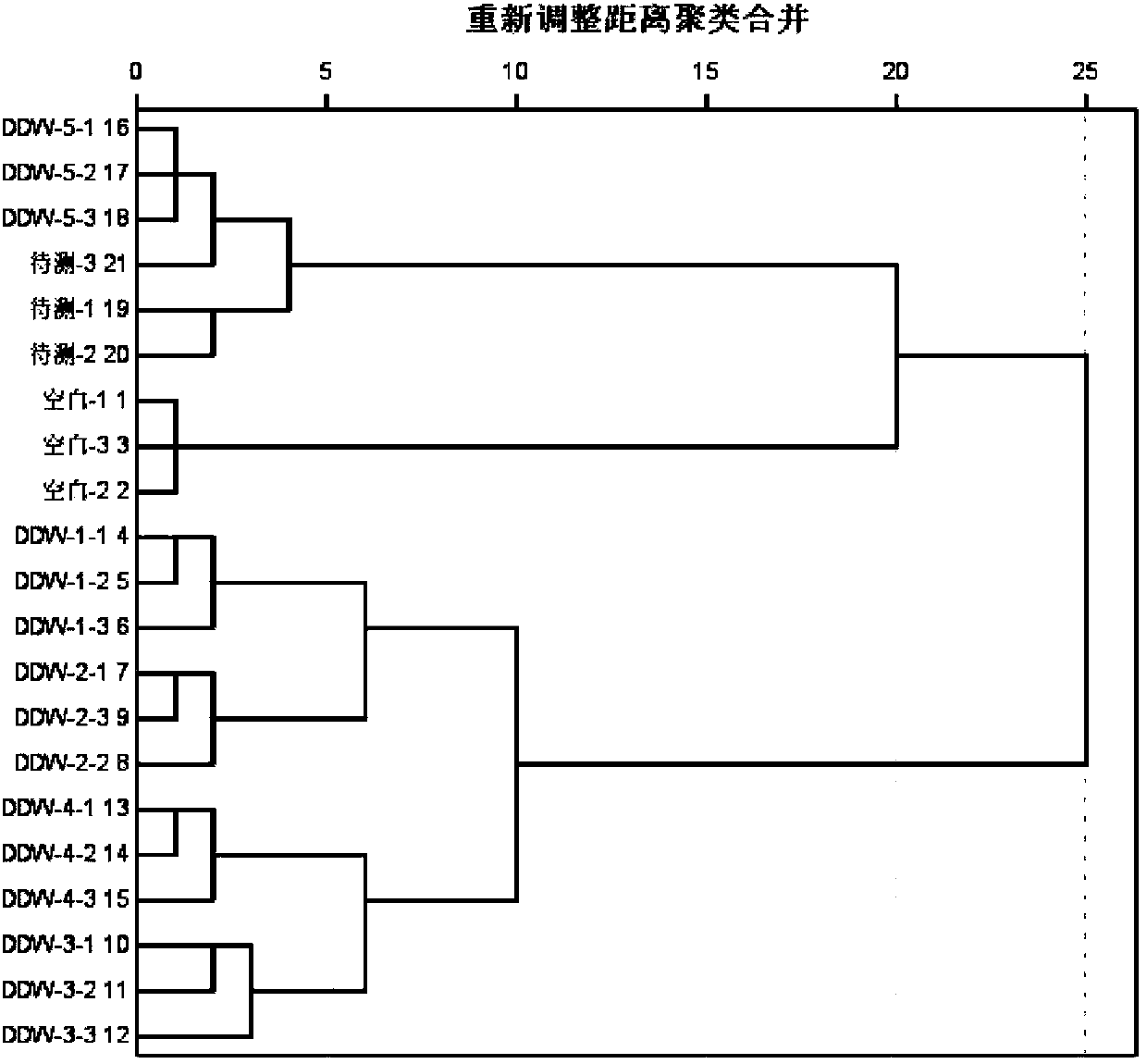Detection method of organophosphorus pesticide
An organophosphorus pesticide and sample technology, which is applied in biochemical equipment and methods, microbial determination/inspection, and analysis by chemical reaction of materials, etc., can solve the application and promotion of restriction enzyme inhibition biosensors, restriction enzyme inhibition biosensors Problems such as application and measurement results cannot be displayed intuitively, so as to facilitate rapid on-site detection, improve detection selectivity, and be easy to observe.
- Summary
- Abstract
- Description
- Claims
- Application Information
AI Technical Summary
Problems solved by technology
Method used
Image
Examples
preparation example Construction
[0037] (3) Preparation of visual sensing array
[0038]After steps (1) and (2) are completed, use a quartz capillary with a diameter of 150-200 μm to spot the dye solution prepared in step (1) onto the polyvinylidene fluoride membrane by manual spotting to form dots. Array (such as 4×4, 5×5, 6×6 lattice), put it in a desiccator under the protection of nitrogen until it is completely dry, take out the membrane and put it into the sodium hydroxide prepared in step (2) for treatment solution, soak for 5-10 minutes, carry out alkaline treatment, take out the diaphragm, put it in a desiccator under nitrogen protection until it is completely dry, and prepare a visual sensing array.
[0039] (4) Preparation of AChE enzyme solution
[0040] Add distilled water to AChE (500UN), shake and dissolve, and then prepare AChE enzyme solution with an activity unit of 55-60UN.
[0041] (5) Preparation of thioacetylcholine chloride solution
[0042] Distilled water is added into the thioacety...
Embodiment 1
[0063] (1) Preparation of dye solution
[0064] With 14 kinds of pH indicators (including bromocresol green, bromocresol purple, Congo red, chlorophenol red, bromophenol blue, bromophenol red, metamine yellow, methyl red, bromothymol blue, cresol red , bright yellow, nitrazine yellow, thymol blue and indigo carmine) and 2 kinds of porphyrin derivatives (including tetraphenylporphyrin monosulfonate and tetraphenylporphyrin tetrasulfonate) and other 16 kinds of dye substances As the sensing material, with absolute ethanol as solvent, according to the quality of the dye: the volume ratio of absolute ethanol is the ratio of 1:0.6, after adding absolute ethanol to the dye, stirring and fully dissolving, 16 kinds of mass concentrations are prepared respectively. 1.7g / L dye solution, stored at 3°C in the dark.
[0065] (2) Preparation of sodium hydroxide treatment solution
[0066] Add distilled water to the sodium hydroxide, stir and fully dissolve, and prepare a sodium hydroxid...
Embodiment 2
[0092] A visual rapid identification method for micro-trace organophosphorus pesticides, the specific method steps are the same as those in Example 1, wherein:
[0093] In step (1): according to the quality of the dye: the volume ratio of absolute ethanol is 1:0.3, add absolute ethanol to the dye, stir and fully dissolve, and prepare dye solutions with a mass concentration of 5.1g / L respectively , stored at 3.5°C in the dark.
[0094] In step (2): add distilled water to the sodium hydroxide, stir and dissolve fully, and prepare a sodium hydroxide treatment solution with a concentration of 0.001 mol / L.
[0095] Step (3): use a quartz capillary with a diameter of 180 μm to spot the dye solution prepared in step (1) on the polyvinylidene fluoride membrane by manual spotting to form a 4×4 lattice, and put After completely drying in a desiccator under the protection of nitrogen, take out the membrane and put it into the sodium hydroxide treatment solution prepared in step (2), soa...
PUM
| Property | Measurement | Unit |
|---|---|---|
| Sensitivity | aaaaa | aaaaa |
Abstract
Description
Claims
Application Information
 Login to View More
Login to View More - R&D
- Intellectual Property
- Life Sciences
- Materials
- Tech Scout
- Unparalleled Data Quality
- Higher Quality Content
- 60% Fewer Hallucinations
Browse by: Latest US Patents, China's latest patents, Technical Efficacy Thesaurus, Application Domain, Technology Topic, Popular Technical Reports.
© 2025 PatSnap. All rights reserved.Legal|Privacy policy|Modern Slavery Act Transparency Statement|Sitemap|About US| Contact US: help@patsnap.com

